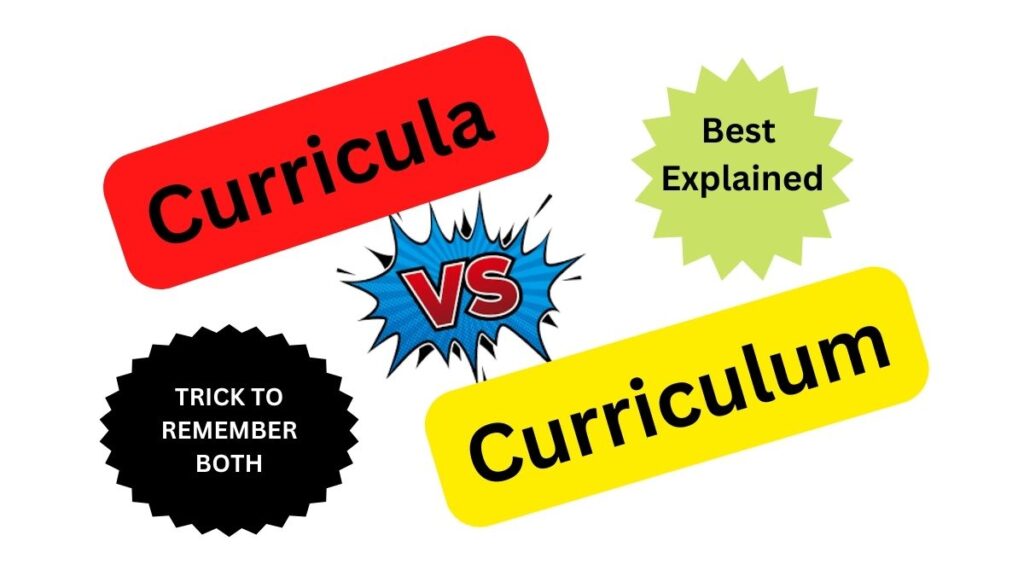
Curricula vs Curriculum Tricks to remember
We are explaining in detail Curricula vs Curriculum here below. “Curriculum” and “curricula” are terms that people use to refer to educational plans and programs. “Curriculum” is a singular noun that refers to a specific plan or program of studies offered by an educational institution, such as a school, college, or university. It encompasses the courses, subjects, and learning experiences that make up a student’s educational journey. On the other hand, “curricula” is the plural form of “curriculum” and refers to multiple educational plans or programs offered by different institutions or in different subject areas. Both “curriculum” and “curricula” play an important role in shaping students’ learning experiences and helping them to achieve their educational goals.
Definition of Curriculum
“Curriculum” refers to the overall plan or program of studies for a school or educational institution. It includes the courses, subjects, and activities that make up the educational program. And defines the objectives and goals that students need to achieve. The curriculum also defines the standards and assessments used to evaluate student progress and success.
Definition of Curricula
On the other hand, “curricula” refers to the actual content and materials used in the courses and lessons within a curriculum. This includes textbooks, lesson plans, assignments, and other resources used to deliver instruction and facilitate learning. Curricula are designed to meet the goals and objectives defined by the broader curriculum and to help students achieve the desired outcomes.
Variation in Curricula: Curricula vs Curriculum
It is important to note that curricula can vary greatly between different schools and educational institutions, even within the same country. For example, a science curriculum in one school might focus on hands-on experiments and field trips, while another school’s science curriculum might emphasize lecture-based instruction and laboratory work.
Considerations When Choosing a School: Curricula vs Curriculum
When choosing a school or educational program, it is important to consider both the curriculum and the curricula. A strong curriculum should provide clear goals and objectives for student learning, while well-designed curricula should provide engaging and effective methods for achieving those goals.
What is the Difference Between Curricula and Curriculum?
“Curriculum” and “curricula” are related terms that refer to educational plans and programs. “Curriculum” is a singular noun that refers to the overall plan or program of studies offered by an educational institution or a teacher. It refers to the courses, subjects, and learning experiences that make up a student’s educational journey. “Curricula” is the plural form of “curriculum” and refers to multiple educational programs or plans. For example, different schools might have different curricula for their students.
When to Use Curriculum
“Curriculum” is typically used when referring to a specific plan or program of study offered by an educational institution, such as a school, college, or university. For example:
- The school’s curriculum includes subjects such as math, science, English, and history.
- The college’s curriculum is designed to prepare students for careers in the healthcare industry.
- The university’s curriculum is constantly evolving to keep up with changing technological advances and job market demands.
Additionally, “curriculum” can also refer to the materials and resources used in teaching, such as textbooks, lesson plans, and assessments. For example:
- The teacher uses a well-designed curriculum to ensure that students are learning effectively and making progress.
- The curriculum includes hands-on activities and projects that help students to apply what they have learned.
When to Use Curricula
Different institutions or subject areas typically use “curricula” when referring to multiple educational plans or programs they offer. For example:
- Different schools have different curricula, with some emphasizing science and technology, while others focus on the arts and humanities.
- The university offers a range of curricula, including programs in engineering, business, education, and liberal arts.
- The education department is currently reviewing and updating all of its curricula to align with new state standards.
In these examples, “curricula” refers to multiple educational plans or programs, not just a single program or plan. The term “curricula” is used to emphasize the fact that there are many different options available, and to distinguish between them.
The trick to Remember the Difference
Here is a trick to remember the difference between “curriculum” and “curricula”:
“Curriculum” is a singular noun that refers to a single educational plan or program, while “curricula” is the plural form that refers to multiple educational plans or programs.


One way to remember this is to think of “curriculum” as a single journey or path that a student takes, while “curricula” refers to multiple paths or journeys that students can choose from.
Another way to remember the difference is to think of “curriculum” as referring to a specific plan or program, such as a school’s curriculum, while “curricula” refers to multiple plans or programs, such as the curricula offered by different schools or universities. In any case, using the correct form of the word helps to convey the intended meaning more accurately and effectively.
Summary
In conclusion, while “curriculum” and “curricula” are often used interchangeably, they refer to slightly different aspects of an educational program. The curriculum defines the overall goals and objectives, while the curricula provide the content and materials used to meet those goals. Both are important to consider when evaluating educational programs and choosing the right school for your needs.



